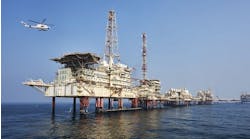Frank Hartley, Houston
Peristaltic pumping technology
These pumps are building a reputation throughout the petrochemical industry as the “pumps for tough applications.” Chuck Treutel, marketing manager of Watson-Marlow Bredel says, “Peristaltic pumps (commonly called hose pumps or tube pumps) have solved pumping problems for decades in a variety of industries from petrochemical, oil & gas, pulp & paper, food processing, mining, paints, pigments and coatings to water and wastewater treatment.” Many peristaltic pump features are unique. These pumps have no valves, seals or glands, and the fluid only comes in contact with the inside of a hose or tube. Chuck says because they are simple to install, easy to operate and quick to maintain, they are the world’s fastest-growing pump type. In fact, many engineers have come to regard peristaltic pumping technology as a problem solver for difficult or even previously “unpumpable” fluids. Chuck said peristaltic pumps combine positive displacement and low maintenance with the ability to handle abrasive and aggressive fluids, such as hydrocarbons and oil products, which wear out many other pump types. This combination of features often proves a cost-effective alternative for difficult pumping.
null
Basic operation principle
“The basic principle of a peristaltic pump is a mechanical application of ‘peristalsis’, a physiological term referring to the alternating contraction and relaxation of muscles around a tube (throat or intestines for example) which force contents through the tube. Understandably, the functionality of this basic principle of mechanical fluid transfer was developed in medical and biotechnology applications,” says Chuck. Basically, a smooth wall flexible tube or hose is squeezed along its length, positively displacing fluid in the tube. The tube’s restitution after the squeeze creates a vacuum, which draws more fluid into the tube, causing a gentle pumping action with minimal damage to the media inside the tube, particularly when compared to other methods of mechanical transfer. Also, because the fluid is contained completely within the tube, the opportunity for contamination is minimal. Chuck acknowledges that these attributes have made peristaltic pump technology attractive for many industrial applications, shaping its evolution into one of the most sought after pump types to handle flow rates and pressures unthinkable 30 years ago.
Hose element
Historically, the fundamental challenge in applying peristaltic technology to industry applications was development of a hose element to handle high pressures and flow rates of highly viscous, abrasive, and chemically aggressive fluids. “The traditional hose design is triple-layered with an extruded inner layer surrounded by a reinforcement cord matrix, and a durable, machined outer layer. This hose element is the ‘heart’ of the pump,” says Chuck. It dictates the suction lift capabilities, discharge pressure capabilities, metering accuracy and repeatability, as well as life of the pump. With new hose materials, construction and manufacturing technology, today’s hose pumps are capable of over 350 gpm, 230 psi and metering accuracy to +/- 1%... while pumping the most abrasive, viscous, and corrosive products imaginable.
Thermoplastic elastomers
Chuck says, “Hydrocarbons and oil products are problematic and difficult to handle using rubber materials. NBR and CSM could be used if only traces of petrochemical product are present; however, the hose is still likely to be attacked by the chemicals.”
Over the past decade many rubber items were replaced by thermoplastic elastomers (TPEs). These materials exhibit an elastic behavior similar to rubber, and can be processed like thermoplastics. As it turns out, TPE was found to be oil resistant and to have the right properties for a peristaltic hose.
Applications
Chuck explains that many companies use organic solvents to make aerosol spray paints, wall paints, lacquers, paint strippers, adhesives, printing ink, spot removers, cosmetics, perfumes and antifreeze products. The ability to handle oil, polymers, fats, fuel oils and cleaning chemicals means these pumps can be used in many applications including printing, pulp and paper, packaging, construction, and manufacturing. The pump can also run dry, so it is ideal for skimming oil film from water.
“Hose pumps have been successful in replacing traditional pump types in corrosive, viscous and abrasive handling applications, says Chuck. A traditional pump typically operates with the rotor and stator in the product zone. Abrasive particles in the product quickly open up critical tolerances between the rotor and stator, causing a drop-off in pumping efficiency and eventual failure. Traditional positive displacement pumps require tight tolerances in order to function.
Chuck explains that a hose pump rotor is out of the pumped-product zone and never touches the pumped media. The hose is the only part to touch the product, keeping abrasive pump wear to a minimum. A properly selected heavy-duty pump hose does not fail due to abrasive wear; it fails from fatigue, and number of compressions. Regardless of the product, whether it is abrasive lime slurry or nonabrasive polymer, the hose life is the same.
“Chemical metering is another area in which hose pumps have become an exceptional alternative to traditional pumping and metering methods,” says Chuck. Many process streams controlled by a combination of pumps and flowmeters can be served with a well-designed hose pump and tachometer at considerable savings in equipment costs. High concentrations of caustic materials or particulate matter can attack the wetted parts of the flowmeter and affect measurement reliability. Viscous media can coat flow sensors, affecting measurement, and many slurries also have proven difficult to measure with a flowmeter. With a hose pump, the chemically compatible hose material can be selected prior to installation, and fluid characteristics or process pressure will not affect the metering accuracy of the pump. Chuck explains that hose pumps have been employed successfully in a wide variety of highly automated metering applications, with accurate control of flow rate and total flow by regulating of pump speed. Another nice feature of the peristaltic design when integrated into more complex systems is that the pump can act as its own check valve. Some portion of the hose or tube always is occluded, so when the pump stops, that point stays squeezed shut. This feature removes the need for an additional valve to prevent over-dosing or backflow.




